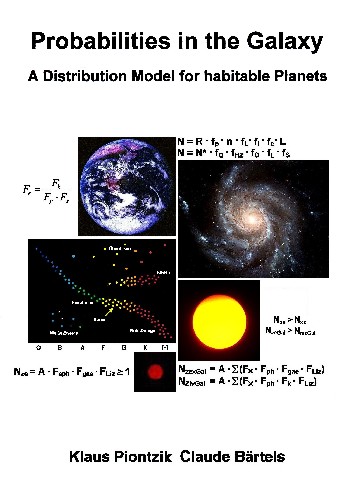 |
Only three of
the eight levels of development represent higher technological
civilizations, namely levels 6, 7, 8.
This corresponds to a probability of:
Fz = 14,400/7,301 · (1:36+1:49+1:64)
Fz= 405,225/3,218,741 = 1:7,943 |
| |
|
| FLiz
= FL·Fi·Fz |
= 1:9
· 1:14 · 405,225/3,218,741
= 0.000,999,171
= 1 : 1001 technological
civilization |
|
Since
two values exist for Fe and Fgae a minimum-maximum
statement can also be generated here.
Inserting all values (Fe = 0.1) into equation 6.3.3:
Nze1 = (100-300)·109
· 1:15,000 · 1:69 · 1:1001
Nze1 = 97 – 290
„Earth 2“ with a technological civilisztion
Inserting all values (Fe = 0.01) into equation
6.3.3:
Nze2 = (100-300)·109
· 1:15,000 · 1:691 · 1:1001
Nze2 = 10 – 29
„Earth 2“ with a technological civilisztion
The two results can then be summarized to the following
statement:
| 6.4.1 Theorem |
There are probably 10 to 290
technological civilizations on an "Earth
2" in a solar-like star system, in our
galaxy. |
The
probability of a habitable "Earth 2", with a
technological civilization, in solar-like star systems,
in our galaxy, is then:
| 6.4.2 Definition |
Fze
= Fsph
· Fgae ·
FLiz |
|
Fze= Fsph·Fgae·FLiz
Fze = 1:15,000 · (1:69-1:691)
· 1:1001
Fze = 1:1,036,035,000 -
10,375,365,000
Only every 1.036 to 10.375 billionth
star system produces an "Earth 2", with a
technological civilization.
|
